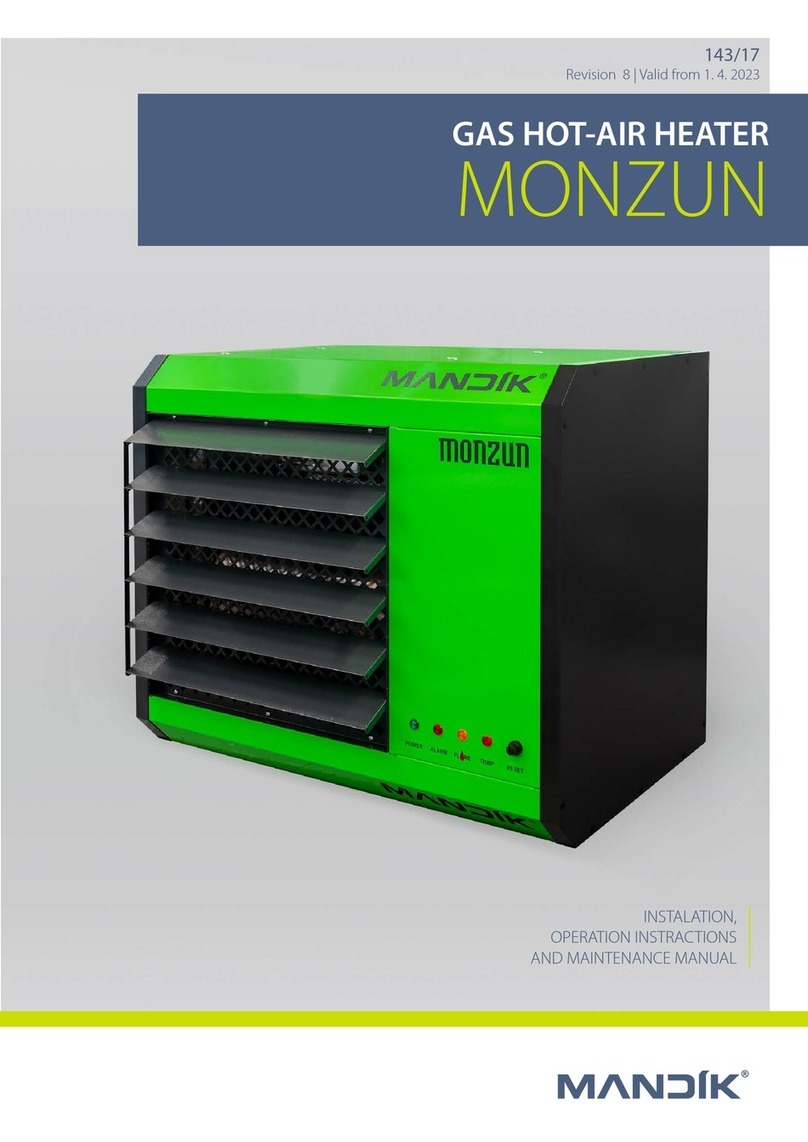
3
Dark tube infrared heater HELIOS (On/Off) and HELIOS D (two-stage) in the performance series from
10 to 50 kW is a modern ecological gas heater.
In terms of operating temperature of active surfaces and thus in terms of the particular wavelength of
the emitted radiation, the device belongs to the category of so-called "dark" infrared heaters. The active
surface is formed by radiant pipes and a reflector. In the radiant pipes there is the process of fuel gas
burning and there are also burnt gases flowing through the pipes to the mouth of the exhaust fan. Fuel
burning is carried out by an atmospheric burner which is automatically controlled. The reflector prevents
the pipes from cooling by the process of convection. The reflector itself warms up by the radiant pipes
and radiates the heat in the required direction.
Normal operating fuel of the HELIOS infrared heaters:
●natural gas – NG (G20/G25)
●propane – P (G31)
Product category:
●II2E3B/P, II2ELL3B/P, design A2, B22, C12, C32, C62. Třída NOX 3 (acc. EN 416-1/A1).
Infrared heaters HELIOS are intended for environment protected against weather impacts with the
classification of climatic conditions class 3K5 acc. EN 60721-3-3 with temperature range from 0° to
35°C, for BNV premises acc. EN 1127-1. Installing infrared heaters as design C is possible, except of
normal spaces also in areas intended for decommissioning and maintenance of vehicles. Such
installation must be assessed by the competent authorities in accordance with the applicable regulations.
Infrared heaters cannot be installed in individual, row and collective garages, motor vehicle garages and
operating rooms of fuel filling stations with fuel dispensers. Infrared heaters cannot also be installed in
places where there is a risk of fire or explosion or high levels of flammable dust.
Infrared heaters are suspended under the ceiling or on the walls in the upper areas of the buildings so
that the radiated beams point to the floor towards the heated residential zone. The surfaces of floors,
walls, machines and other objects are heated by radiation and the surrounding air is heated from them.
The infrared heater HELIOS consists of the following main parts:
●
● with hinges and the radiant heating tubes "U" or "I"
The basic design of the burner box is scalded by the throat for the external suction in the upper part of
the burner box. If the combustion air supply system is not connected, it is an open gas appliance. Thus,
infrared heaters can only be used in a basic (normal) environment according to the according to the
relevant standard. In order to be considered as a closed gas appliance, the radiator must be connected
to outdoor air intake system.
● Infrared heater operation is controlled by the located in the burner box.
● After connecting to the el. network, first the basic test of the connected devices to the automatic is
performed and if everything is OK, the exhaust fan is activated.
● After the fan starts and a vacuum is evoked in the burner chamber, the differential air manostat is
switched. The manostat senses the pressure differential caused by the exhaust fan.
● When the manostat is switched on, the venting time (approx. 50 s) starts to run, this is used to
ventilate the flue gas exhaust pipe and heating tubes.
● After this ventilation time, the electromagnetic double valve is opened and gas is injected into the
burner. At the same time, the ignition system is put into operation by the automatic system.
● The ignition of the gas mixture in the burner is detected by the ionisation electrode.
● If the gas mixture in the burner is not ignited within 5 seconds, the valve closes the gas supply and
the unburned gas / air mixture is vented through the exhaust fan during the next ventilation time. After
it has elapsed, the automation runs two more ignition cycles.
● If no flame is detected during the third ignition cycle, the automatic switches into the fault mode and
the red indicator “Burner Failure” light on.
● Further start is possible after unlocking the fault condition by disconnecting and reconnecting to the
power supply.
● After putting the burner into operation and igniting the gas mixture, the green indicator "Power
supply" and orange indicator "Burner Operation" lights up.





























